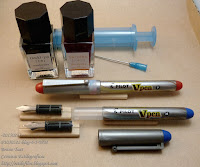That was the case of the following pen.
And this pen's story is told through the contents of the box: what looks like a wrapping paper, and a hand-written text in Japanese.
 The wrapping paper. Note the faint writing around the circular FVS logo on the upper right area of the paper.
The wrapping paper. Note the faint writing around the circular FVS logo on the upper right area of the paper.
The wrapping paper likely belongs to the shop “Julius Vaternahm” in Frankfurt (am Main) in Germany. A quick research online tells us that the publishing company Julius Vaternahm had also been very successful through the business of station bookshops.
There is also a faint annotation in Japanese made with a pencil on the paper. It reads something like “Uehara-sama”, 植原様.
The handwritten text inside the box is a lot more informative. It says that (the pen) had been a gift of the Governor of Osaka Satô after his trip to Germany between February 3rd and 13th 1962.
So here we have a Lamy pen that found its way from Frankfurt to Japan in the luggage of a prominent Japanese politician in 1962 to be given away to friends or political supporters. And that Mr. Uehara on the wrapping paper was possibly one of them.
It would be interesting to know how many pens the Governor --and his entourage-- had purchased during his time in Germany, and whether all of them were Lamy or some other brands were also included.
The Lamy 37 is surprisingly absent from the usual sources of information (*), and nothing very specific can be said about it. It certainly shows some similarities with the very popular 27, but the 37 does not match any of the numerous documented variations. A very comprehensive document on the Lamy 27 was published in the Fountain Pen Network in 2017 (thanks, Christof!).
The Lamy 37 is a piston filler with a semi-hooded nib, made of 58.5% gold. The feed is clear and transluscent.
The cap is made of steel, and has the brand name engraved on the clip and on the cap lip. There is no logo on the cap jewel, which seems to be a feature on 1962 models and beyond.
The body is made of plastic and includes four ink windows. The brand name, in a rounder font, is imprinted on the barrel. The model name and the nib point are declared on the piston knob.
These are the dimensions of the Lamy 37:
Length closed: 133 mm
Length open: 123 mm
Length posted: 146 mm
Diameter: 11.8 mm
Weight: 15.9 g (dry)
Ink deposit: 1.4 ml
And about 60 years later, Lamy became Japanese.
(*) The video on this link is the only source of information specifically on the Lamy 37 I have found online so far. Note it refers to a newer version of the model which includes a logo on the cap jewel.
My thanks to Poplicola-san.
Parker 75 – Diamine Bilberry
Bruno Taut
March 25th, 2025
labels: Lamy, Alemania, Japón
Bruno Taut
March 25th, 2025
labels: Lamy, Alemania, Japón
































































